key FORD SIERRA 1992 2.G Body Electrical System Workshop Manual
[x] Cancel search | Manufacturer: FORD, Model Year: 1992, Model line: SIERRA, Model: FORD SIERRA 1992 2.GPages: 25, PDF Size: 1.7 MB
Page 4 of 25
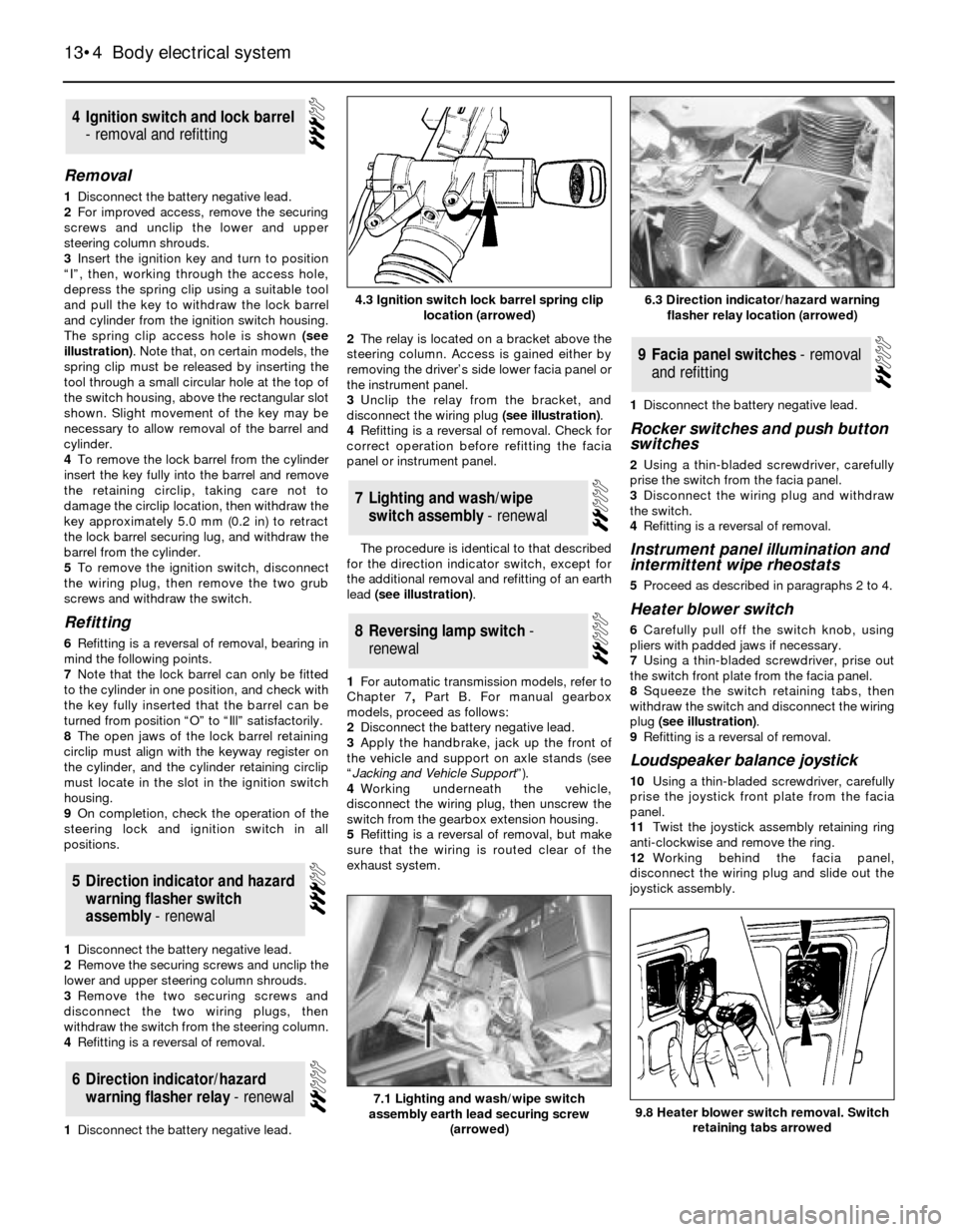
Removal
1Disconnect the battery negative lead.
2For improved access, remove the securing
screws and unclip the lower and upper
steering column shrouds.
3Insert the ignition key and turn to position
“I”, then, working through the access hole,
depress the spring clip using a suitable tool
and pull the key to withdraw the lock barrel
and cylinder from the ignition switch housing.
The spring clip access hole is shown (see
illustration). Note that, on certain models, the
spring clip must be released by inserting the
tool through a small circular hole at the top of
the switch housing, above the rectangular slot
shown. Slight movement of the key may be
necessary to allow removal of the barrel and
cylinder.
4To remove the lock barrel from the cylinder
insert the key fully into the barrel and remove
the retaining circlip, taking care not to
damage the circlip location, then withdraw the
key approximately 5.0 mm (0.2 in) to retract
the lock barrel securing lug, and withdraw the
barrel from the cylinder.
5To remove the ignition switch, disconnect
the wiring plug, then remove the two grub
screws and withdraw the switch.
Refitting
6Refitting is a reversal of removal, bearing in
mind the following points.
7Note that the lock barrel can only be fitted
to the cylinder in one position, and check with
the key fully inserted that the barrel can be
turned from position “O” to “Ill” satisfactorily.
8The open jaws of the lock barrel retaining
circlip must align with the keyway register on
the cylinder, and the cylinder retaining circlip
must locate in the slot in the ignition switch
housing.
9On completion, check the operation of the
steering lock and ignition switch in all
positions.
1Disconnect the battery negative lead.
2Remove the securing screws and unclip the
lower and upper steering column shrouds.
3Remove the two securing screws and
disconnect the two wiring plugs, then
withdraw the switch from the steering column.
4Refitting is a reversal of removal.
1Disconnect the battery negative lead.2The relay is located on a bracket above the
steering column. Access is gained either by
removing the driver’s side lower facia panel or
the instrument panel.
3Unclip the relay from the bracket, and
disconnect the wiring plug (see illustration).
4Refitting is a reversal of removal. Check for
correct operation before refitting the facia
panel or instrument panel.
The procedure is identical to that described
for the direction indicator switch, except for
the additional removal and refitting of an earth
lead (see illustration).
1For automatic transmission models, refer to
Chapter 7, PartB. For manual gearbox
models, proceed as follows:
2Disconnect the battery negative lead.
3Apply the handbrake, jack up the front of
the vehicle and support on axle stands (see
“Jacking and Vehicle Support”).
4Working underneath the vehicle,
disconnect the wiring plug, then unscrew the
switch from the gearbox extension housing.
5Refitting is a reversal of removal, but make
sure that the wiring is routed clear of the
exhaust system.1Disconnect the battery negative lead.
Rocker switches and push button
switches
2Using a thin-bladed screwdriver, carefully
prise the switch from the facia panel.
3Disconnect the wiring plug and withdraw
the switch.
4Refitting is a reversal of removal.
Instrument panel illumination and
intermittent wipe rheostats
5Proceed as described in paragraphs 2 to 4.
Heater blower switch
6Carefully pull off the switch knob, using
pliers with padded jaws if necessary.
7Using a thin-bladed screwdriver, prise out
the switch front plate from the facia panel.
8Squeeze the switch retaining tabs, then
withdraw the switch and disconnect the wiring
plug (see illustration).
9Refitting is a reversal of removal.
Loudspeaker balance joystick
10Using a thin-bladed screwdriver, carefully
prise the joystick front plate from the facia
panel.
11Twist the joystick assembly retaining ring
anti-clockwise and remove the ring.
12Working behind the facia panel,
disconnect the wiring plug and slide out the
joystick assembly.
9Facia panel switches - removal
and refitting
8Reversing lamp switch -
renewal
7Lighting and wash/wipe
switch assembly - renewal
6Direction indicator/hazard
warning flasher relay - renewal
5Direction indicator and hazard
warning flasher switch
assembly - renewal
4Ignition switch and lock barrel
- removal and refitting
13•4Body electrical system
4.3 Ignition switch lock barrel spring clip
location (arrowed)
7.1 Lighting and wash/wipe switch
assembly earth lead securing screw
(arrowed)9.8 Heater blower switch removal. Switch
retaining tabs arrowed
6.3 Direction indicator/hazard warning
flasher relay location (arrowed)
Page 18 of 25
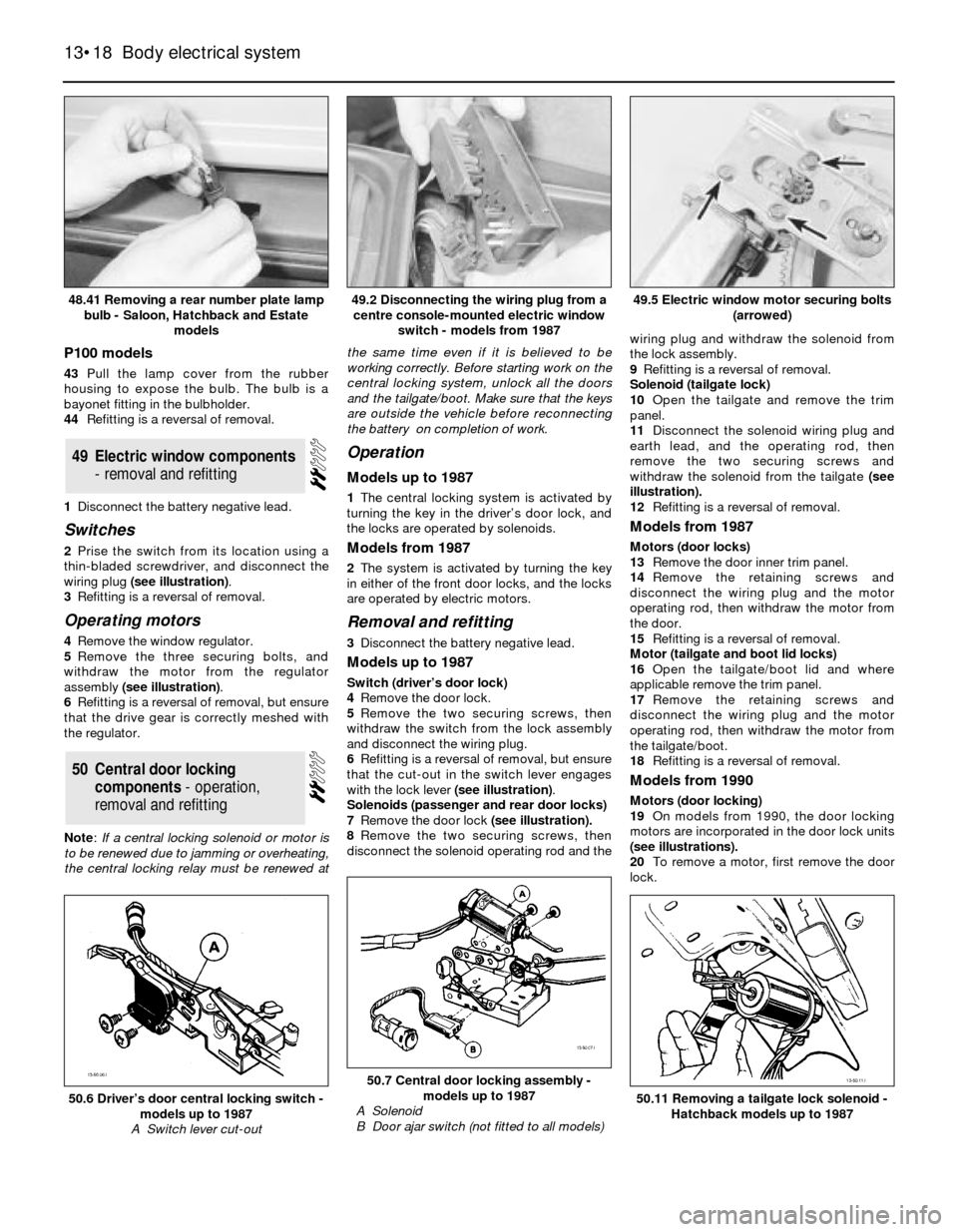
P100 models
43Pull the lamp cover from the rubber
housing to expose the bulb. The bulb is a
bayonet fitting in the bulbholder.
44Refitting is a reversal of removal.
1Disconnect the battery negative lead.
Switches
2Prise the switch from its location using a
thin-bladed screwdriver, and disconnect the
wiring plug (see illustration).
3Refitting is a reversal of removal.
Operating motors
4Remove the window regulator.
5Remove the three securing bolts, and
withdraw the motor from the regulator
assembly (see illustration).
6Refitting is a reversal of removal, but ensure
that the drive gear is correctly meshed with
the regulator.
Note:If a central locking solenoid or motor is
to be renewed due to jamming or overheating,
the central locking relay must be renewed atthe same time even if it is believed to be
working correctly. Before starting work on the
central locking system, unlock all the doors
and the tailgate/boot. Make sure that the keys
are outside the vehicle before reconnecting
the battery on completion of work.
Operation
Models up to 1987
1The central locking system is activated by
turning the key in the driver’s door lock, and
the locks are operated by solenoids.
Models from 1987
2The system is activated by turning the key
in either of the front door locks, and the locks
are operated by electric motors.
Removal and refitting
3Disconnect the battery negative lead.
Models up to 1987
Switch (driver’s door lock)
4Remove the door lock.
5Remove the two securing screws, then
withdraw the switch from the lock assembly
and disconnect the wiring plug.
6Refitting is a reversal of removal, but ensure
that the cut-out in the switch lever engages
with the lock lever (see illustration).
Solenoids (passenger and rear door locks)
7Remove the door lock (see illustration).
8Remove the two securing screws, then
disconnect the solenoid operating rod and thewiring plug and withdraw the solenoid from
the lock assembly.
9Refitting is a reversal of removal.
Solenoid (tailgate lock)
10Open the tailgate and remove the trim
panel.
11Disconnect the solenoid wiring plug and
earth lead, and the operating rod, then
remove the two securing screws and
withdraw the solenoid from the tailgate(see
illustration).
12Refitting is a reversal of removal.
Models from 1987
Motors (door locks)
13Remove the door inner trim panel.
14Remove the retaining screws and
disconnect the wiring plug and the motor
operating rod, then withdraw the motor from
the door.
15Refitting is a reversal of removal.
Motor (tailgate and boot lid locks)
16Open the tailgate/boot lid and where
applicable remove the trim panel.
17Remove the retaining screws and
disconnect the wiring plug and the motor
operating rod, then withdraw the motor from
the tailgate/boot.
18Refitting is a reversal of removal.
Models from 1990
Motors (door locking)
19On models from 1990, the door locking
motors are incorporated in the door lock units
(see illustrations).
20To remove a motor, first remove the door
lock.
50Central door locking
components - operation,
removal and refitting
49Electric window components
- removal and refitting
13•18Body electrical system
48.41 Removing a rear number plate lamp
bulb - Saloon, Hatchback and Estate
models49.5 Electric window motor securing bolts
(arrowed)
50.7 Central door locking assembly -
models up to 1987
A Solenoid
B Door ajar switch (not fitted to all models)
50.6 Driver’s door central locking switch -
models up to 1987
A Switch lever cut-out
49.2 Disconnecting the wiring plug from a
centre console-mounted electric window
switch - models from 1987
50.11 Removing a tailgate lock solenoid -
Hatchback models up to 1987
Page 21 of 25
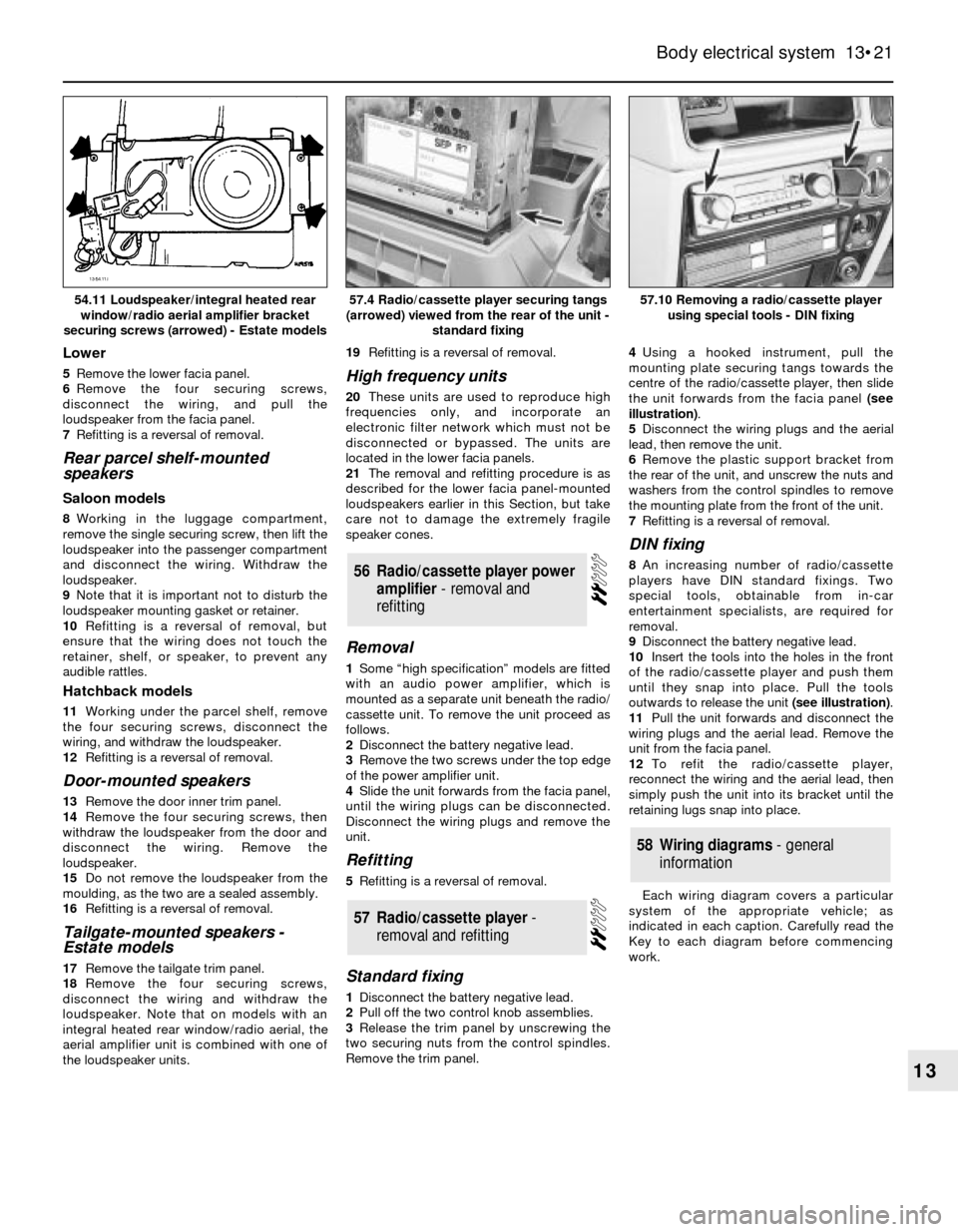
Lower
5Remove the lower facia panel.
6Remove the four securing screws,
disconnect the wiring, and pull the
loudspeaker from the facia panel.
7Refitting is a reversal of removal.
Rear parcel shelf-mounted
speakers
Saloon models
8Working in the luggage compartment,
remove the single securing screw, then lift the
loudspeaker into the passenger compartment
and disconnect the wiring. Withdraw the
loudspeaker.
9Note that it is important not to disturb the
loudspeaker mounting gasket or retainer.
10Refitting is a reversal of removal, but
ensure that the wiring does not touch the
retainer, shelf, or speaker, to prevent any
audible rattles.
Hatchback models
11Working under the parcel shelf, remove
the four securing screws, disconnect the
wiring, and withdraw the loudspeaker.
12Refitting is a reversal of removal.
Door-mounted speakers
13Remove the door inner trim panel.
14Remove the four securing screws, then
withdraw the loudspeaker from the door and
disconnect the wiring. Remove the
loudspeaker.
15Do not remove the loudspeaker from the
moulding, as the two are a sealed assembly.
16Refitting is a reversal of removal.
Tailgate-mounted speakers -
Estate models
17Remove the tailgate trim panel.
18Remove the four securing screws,
disconnect the wiring and withdraw the
loudspeaker. Note that on models with an
integral heated rear window/radio aerial, the
aerial amplifier unit is combined with one of
the loudspeaker units.19Refitting is a reversal of removal.
High frequency units
20These units are used to reproduce high
frequencies only, and incorporate an
electronic filter network which must not be
disconnected or bypassed. The units are
located in the lower facia panels.
21The removal and refitting procedure is as
described for the lower facia panel-mounted
loudspeakers earlier in this Section, but take
care not to damage the extremely fragile
speaker cones.
Removal
1Some “high specification” models are fitted
with an audio power amplifier, which is
mounted as a separate unit beneath the radio/
cassette unit. To remove the unit proceed as
follows.
2Disconnect the battery negative lead.
3Remove the two screws under the top edge
of the power amplifier unit.
4Slide the unit forwards from the facia panel,
until the wiring plugs can be disconnected.
Disconnect the wiring plugs and remove the
unit.
Refitting
5Refitting is a reversal of removal.
Standard fixing
1Disconnect the battery negative lead.
2Pull off the two control knob assemblies.
3Release the trim panel by unscrewing the
two securing nuts from the control spindles.
Remove the trim panel.4Using a hooked instrument, pull the
mounting plate securing tangs towards the
centre of the radio/cassette player, then slide
the unit forwards from the facia panel (see
illustration).
5Disconnect the wiring plugs and the aerial
lead, then remove the unit.
6Remove the plastic support bracket from
the rear of the unit, and unscrew the nuts and
washers from the control spindles to remove
the mounting plate from the front of the unit.
7Refitting is a reversal of removal.
DIN fixing
8An increasing number of radio/cassette
players have DIN standard fixings. Two
special tools, obtainable from in-car
entertainment specialists, are required for
removal.
9Disconnect the battery negative lead.
10Insert the tools into the holes in the front
of the radio/cassette player and push them
until they snap into place. Pull the tools
outwards to release the unit (see illustration).
11Pull the unit forwards and disconnect the
wiring plugs and the aerial lead. Remove the
unit from the facia panel.
12To refit the radio/cassette player,
reconnect the wiring and the aerial lead, then
simply push the unit into its bracket until the
retaining lugs snap into place.
Each wiring diagram covers a particular
system of the appropriate vehicle; as
indicated in each caption. Carefully read the
Key to each diagram before commencing
work.
58Wiring diagrams - general
information
57Radio/cassette player -
removal and refitting
56Radio/cassette player power
amplifier - removal and
refitting
Body electrical system 13•21
13
57.10 Removing a radio/cassette player
using special tools - DIN fixing57.4 Radio/cassette player securing tangs
(arrowed) viewed from the rear of the unit -
standard fixing54.11 Loudspeaker/integral heated rear
window/radio aerial amplifier bracket
securing screws (arrowed) - Estate models
Page 22 of 25
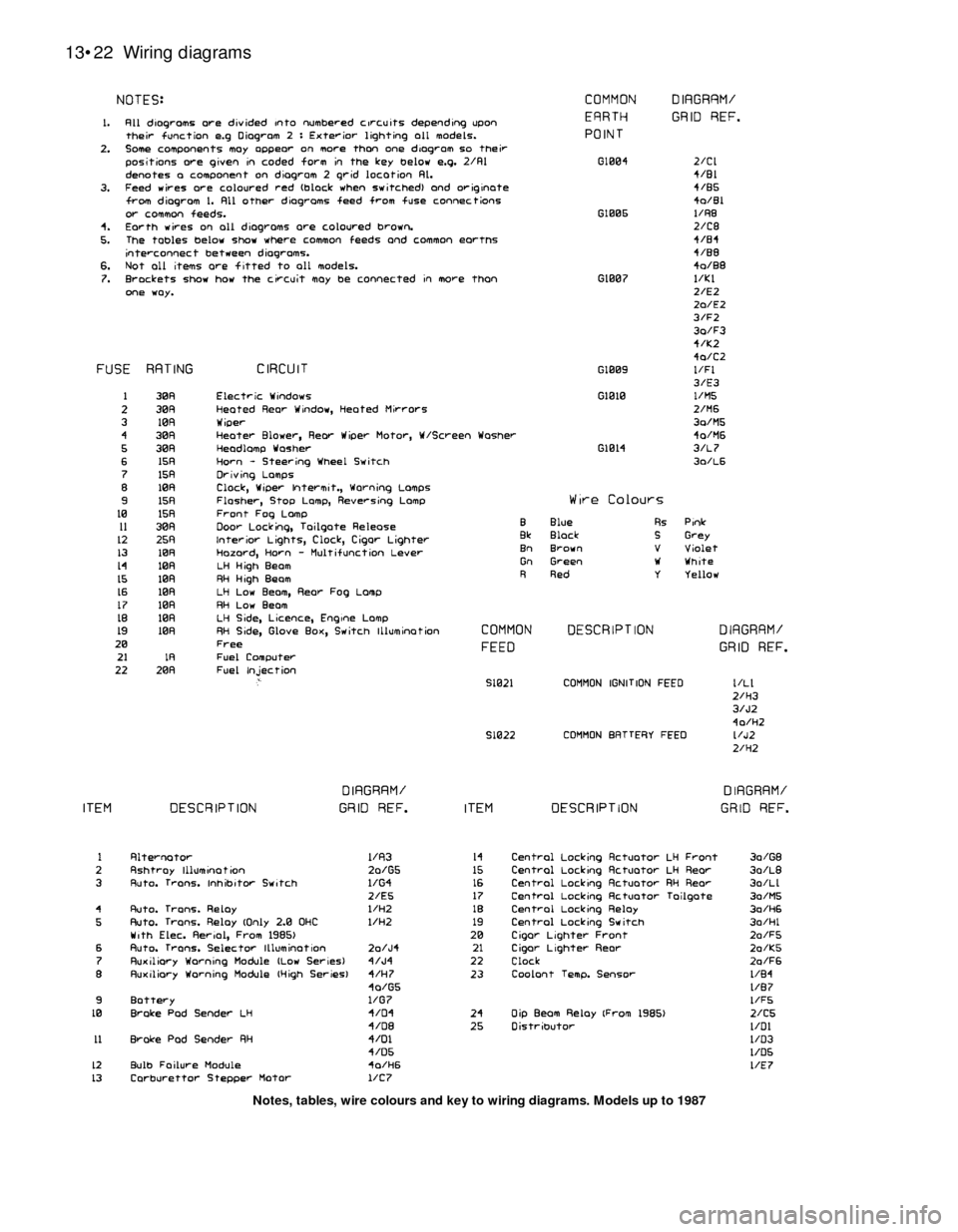
13•22Wiring diagrams
Notes, tables, wire colours and key to wiring diagrams. Models up to 1987
Page 23 of 25
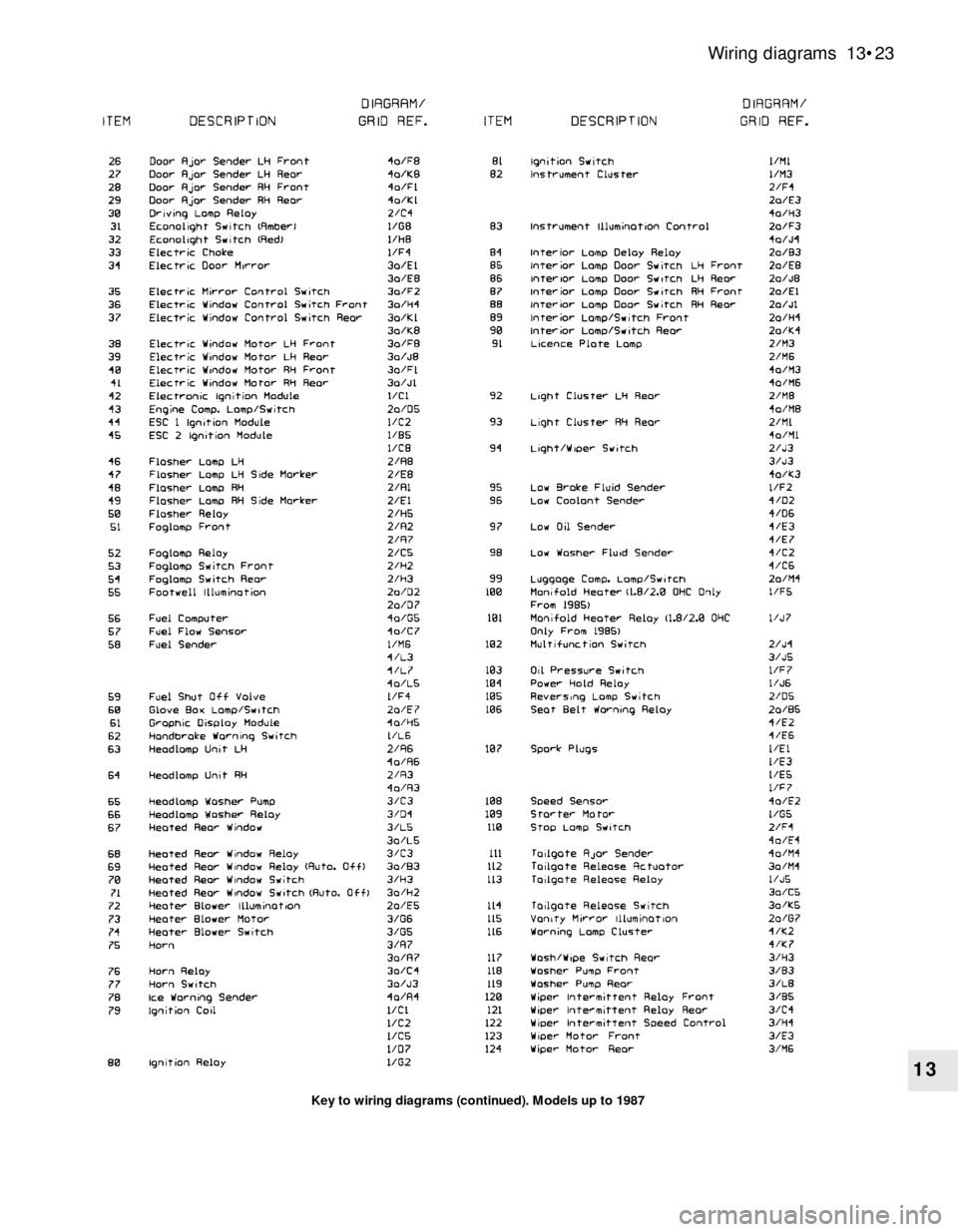
13
Wiring diagrams 13•23
Key to wiring diagrams (continued). Models up to 1987